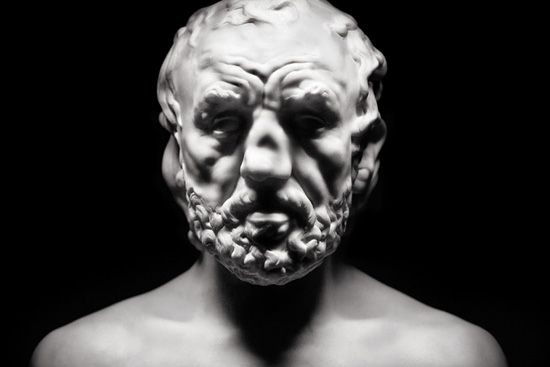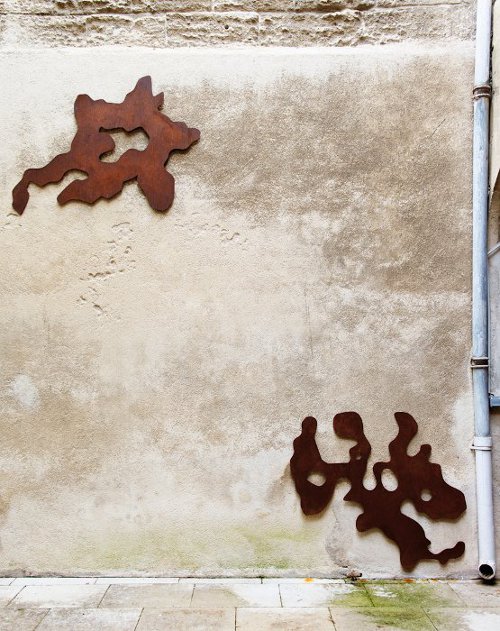
The photograph that the author has given to the Musée Réattu collections (pigment ink print, 100 x 150 cm Ex. 1/8), was originally specially produced for the exhibition Rodin, la lumière de l'antique, held at the Musée départemental Arles antique from 6th April to 1st September 2013. Back then it was presented opposite an original bronze by Auguste Rodin, produced during the winter of 1864-1865 and called L’Homme au nez cassé.
In the winter of 1864-1865, Rodin produced a portrait of a man from his studio, Bibi, whose extremely troubled facial expressions seem to particularly interest the artist, who uncompromisingly models his deformed crushed nose and marked lines by a tough life. He exhibited the work for the first time at the Salon in 1865, in the form of a bronze mask. The incomplete nature – heralding his future work on partial figures – combined with the realism of the face resulted in him being refused. But this work visibly represents a key stage in the sculptor’s work.
Presented once again at the Salon in 1875, L’Homme au nez cassé was accepted, but this was a more academic version of it carved in marble, which draws heavily on the vocabulary of ancient statuary.
The photograph L’Homme au nez cassé is part of a broader photographic series, called Figures du pouvoir. Olivier Roller focuses on the question of power, examining four types of different models: effigies of Roman emperors, reflecting the origins of power and its vainglory; today’s men of power, referring equally to the hiding power of authority and the fantasy that it represents; his mother, the ultimate symbol of family authority; lastly self-portrait, in which he explores the relationship between photographer and model from an unusual angle. The resulting images, subject to scrutiny that ignores any form of compromise, just like Rodin serve as so many embodiments of varying aspects of power, its legacy over time, from transmission to decline. The very tight framing of his images, capturing only the heads, isolating or detaching them from the body, just like the intensely dark background in which he immerses the forms, draws parallels between the work of a photographer and that of a sculptor, in the sense that both aesthetical approaches are achieved by removing material. Likewise, the enlargement of the images, produced with a digital camera, is taken to the extreme where the pixel, contemporary photographic grain, encounters the grain of the stone, giving the image the impression of a third dimension, enhanced by dramatic lighting markedly accentuating the volumes and details of the sculpture.

Jean-Blaise Picheral was born in 1946 in Belfort. He moved to Arles in 2008 where he opened the gallery/studio Archipel with the photographer Laura Jonneskindt. An architect and urban planner by training, Jean-Blaise Picheral’s approach to sculpture is very focused, ‘[…] sculpture is not the sculpture itself, but the place created by the sculpture’. This ties in with one of the specialties of the Musée Réattu collection, that from Toni Grand to Bernard Dejonghe or from Hélène Agofroy to Marcel Robelin through to Bernard Pagès has induced commissions of sculptures very closely linked to the architecture of the city and its monuments.
This particular sensitivity, prompted the Musée Réattu, in the context of the exhibition Nuage, to approach the artist to create a work belonging to the series of ‘Portraits empreintes’ on which he has worked for almost 10 years for the museum’s first courtyard. These portraits derive from enlarged fingerprints (forefather to DNA, says J.-B Picheral) of friends or close relations. The scale developed for the museum transcends what the artist had up to then produced, along with the choice of material – crude steel sheets. Jean-Baptiste Picheral’s works reflect Cuerpos celestes by Iñigo Manglano-Ovalle – also featuring in the exhibition with his DNA Portrait of Lisa Lee & DNA Portrait of Kerry James Marshall - and resume one of the exhibition’s main themes, ‘[…] we are made of clouds.’
The physicaland above all not anthropomorphic dimension of these works and their relationship with this new environment naturally called for the acquisition of this series culminating in the pieces presented.